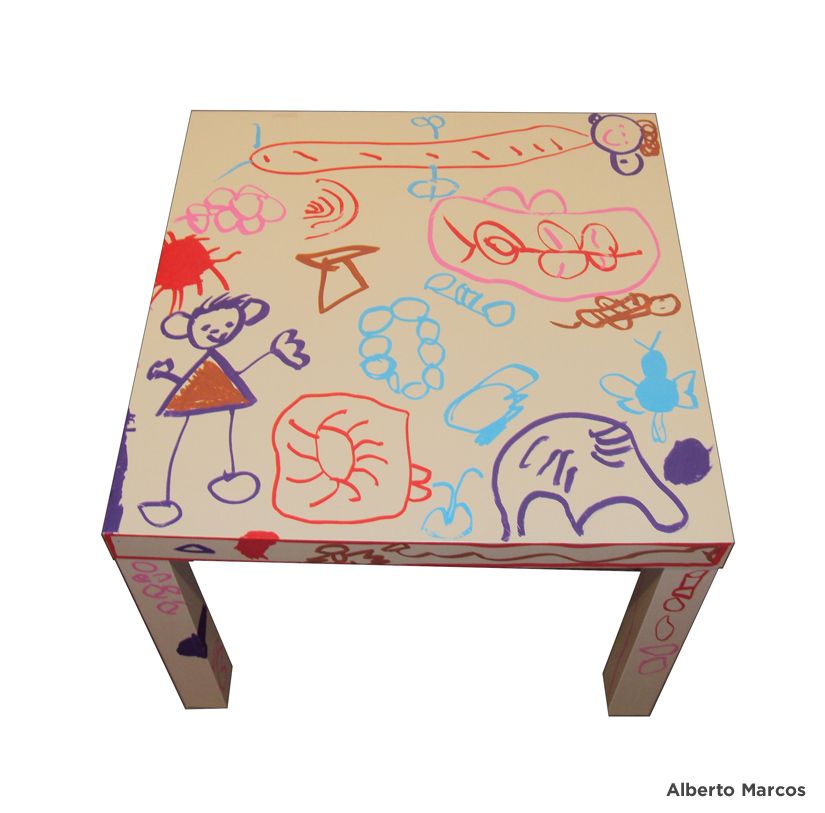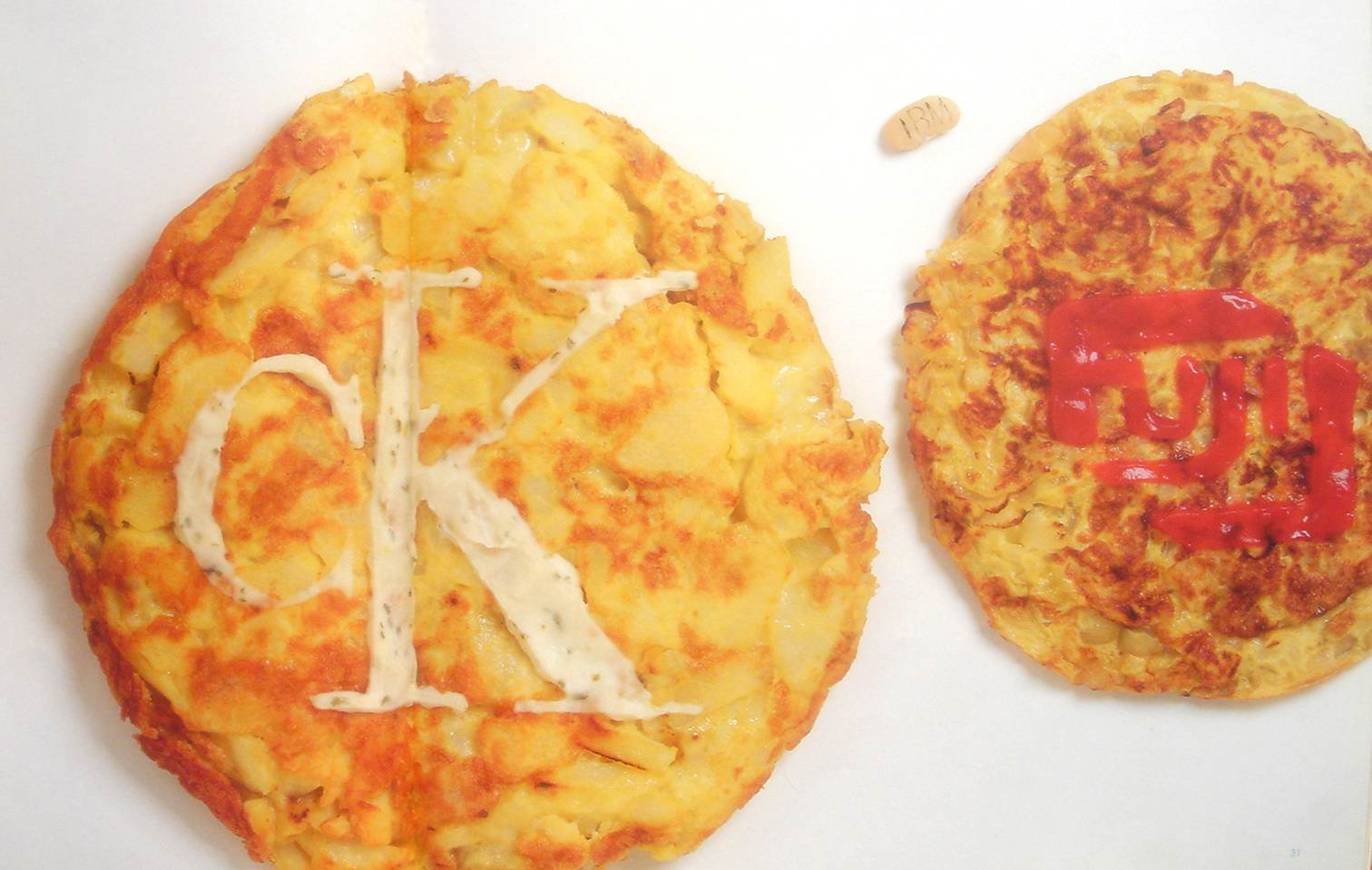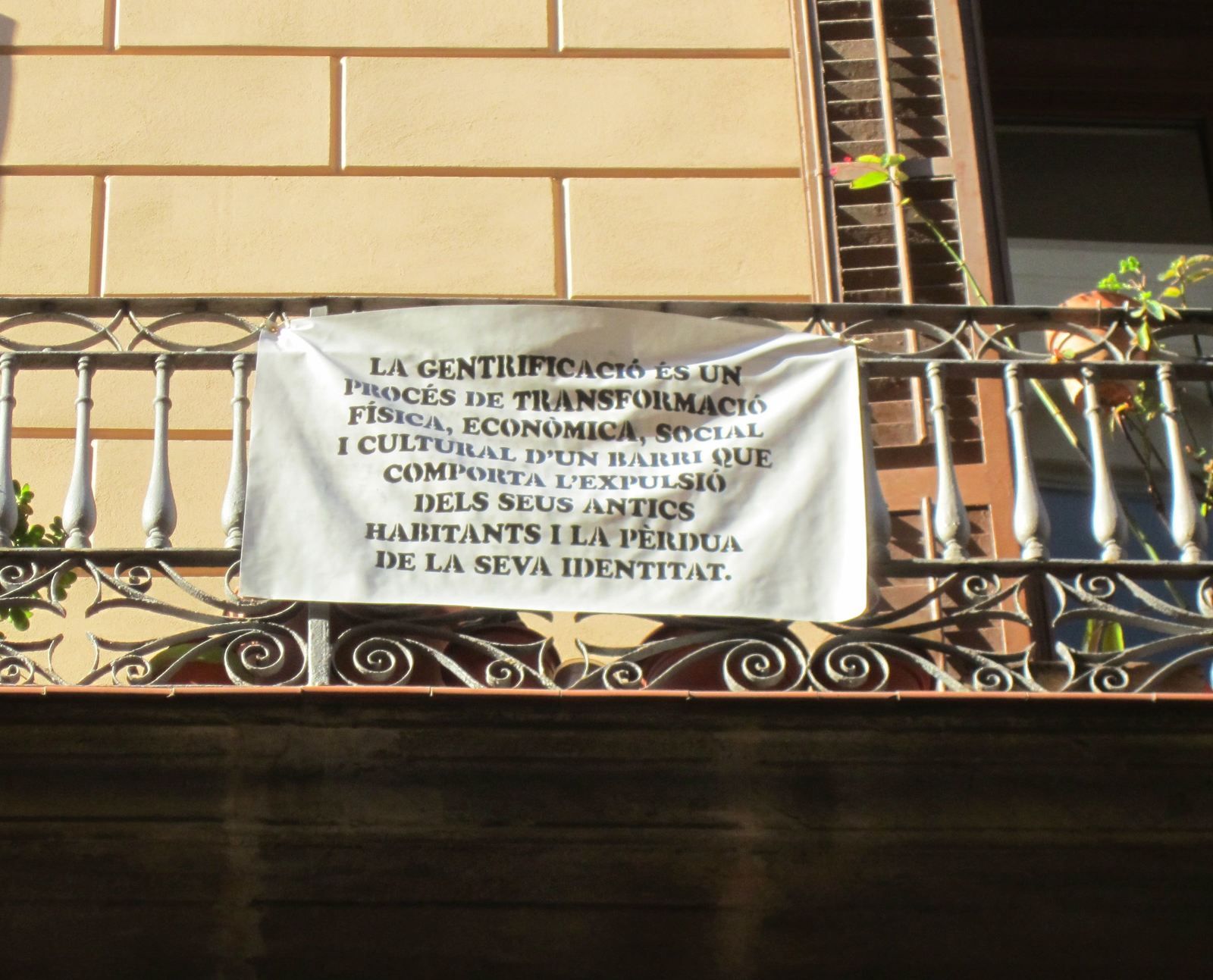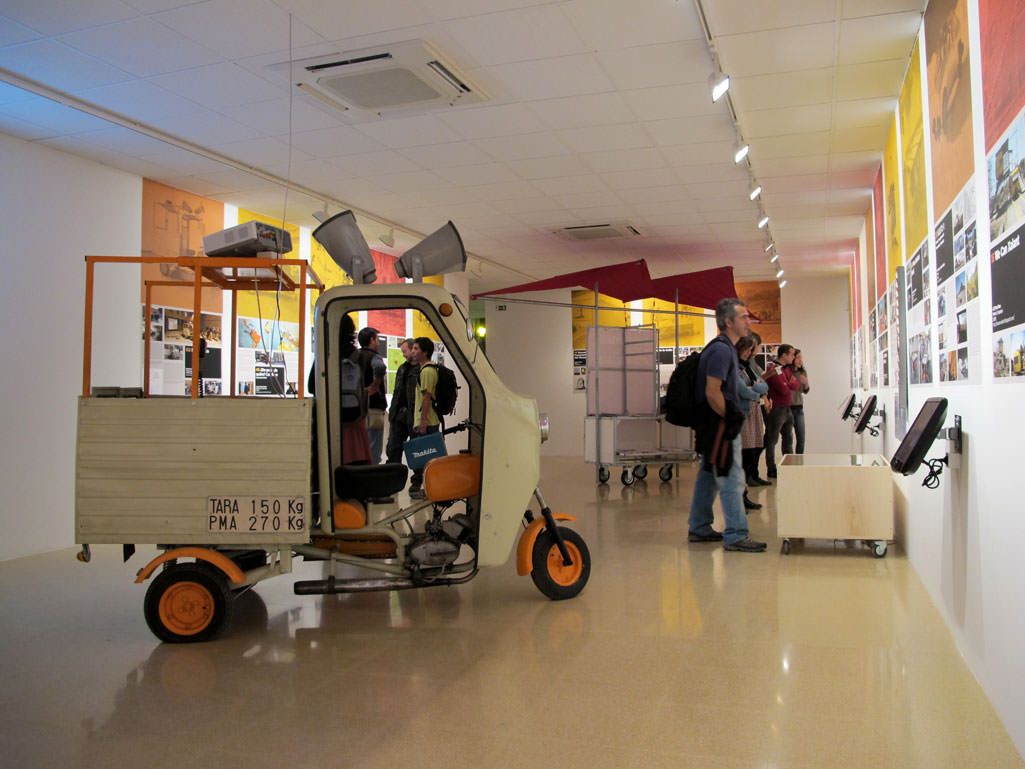ROAMING OF INTERMEDIATE ZONE, ART, DESIGN AND SOCIETY
 17.05.2013 - 28.06.2013
17.05.2013 - 28.06.2013
Unnim Espai Cultura de Sabadell
Exhibtion curated by Curro Claret
Produced by ACVic Centre d'Arts Contemporànies
This exhibition is an intentionally heterogeneous and disparate collection of design, art and architecture projects which affect several aspects of life within society.
These projects demonstrate a commitment from the artists to social problems, and how they accomplish this using parameters beyond their own specialties and practices. A quarantine zone between different creative disciplines, and an area where infection between them may be transmitted, play their part in encouraging the construction of a more responsible, safer, more pleasing and more critical environment than usual. This exhibition highlights and prioritises "human" and "social" factors, over others such as "business" or "formality". It exhibits projects with an aesthetic based upon economy of means, content with fully valid messages, and which openly attempt to capture this message. The pieces selected for the exhibition display projects in very different contexts, and with ambitions to deal with various aspects of social life such as health, food, the elderly, prison conditions, the use of urban space, the 15-M movement, relations between locals and newcomers, relations with other first world countries where labour is "cheaper", or responses to "natural" disasters.
Artlantique - Camper - Emili Padrós - Gemma Busquets - Ikea i Unicef - Katrina Furniture Project (Jenga Mwendo i Tammy Petro) - Laura Arqués, Marta Petreñas i Massimiliano Scaglione - Lee Kiseung - Makea - Mariscal - Martí Guixé - nanimarquina - Pablo España - Recetas Urbanas/Santiago Cirugeda - Shigeru Ban Architects – Domènec – Núria Güell – Viuda De
Exhibition displays made at the workshop Arrels Fundació by Aurelio and Valerio.
Espai Unnim Cultura (C. d'en Font, 25 Sabadell)
[http://www.espaiculturasabadell.cat]
Collaboration:
Arrels Fundació
Alsina Soluciones de encofrados
Capsa
ACTIVITIES RELATED TO THE EXHIBITION:
Round table about the social responsibility of the artist, architect and designer
Jueves 16 de mayo a las 19.30 h
Participants: Santiago Cirugeda, architect and exhibition's participant, Maia Creus, curator and university teacher, Curro Claret, designer and exhibition curator and Pep Dardanyà from Unnim Espai Cultura, table moderator.
Workshop collective constructions by Curro Claret
Saturday 29th June and 6th June from 11 am to 2 pm
Workshop design and construction of furniture or gadgets with the assembly of various materials. Price 45 euros (50% student discount, the price includes the part and participants will take home).
 Artlantique, african upcycling. Artlantique, 2010 - 2012
Artlantique, african upcycling. Artlantique, 2010 - 2012
The fishermen western Africa decorate their boats with colourful geometrical motifs; seen from a distance, in the evening, the beach becomes a huge mosaic of colours. Attracted by its beauty, we ask if whether, after their long ocean voyage, the timber could begin another life, "reincarnate itself" as an item of furniture; few people know as much about the concept of "recycling" as Africans.
Arlantique transforms history, the soul, old west African wooden fishing boats into furniture; every item of is made out of old Senegalese wooden canoes by local carpenters and artisans. The wood, with its colour and its symbols, has no post-treatment; it remains unspoiled, with all its wounds and scars after many years of sailing, preserving its prior status as a boat and sailing the Atlantic, standing witness to the lives of African fishermen.
[http://artlantique.com] Shoes and indigenous art. Camper, 2000
Shoes and indigenous art. Camper, 2000
The world we know consists of over 5.000 different cultures which keep alive what we call diversity, identity or tradition, keywords in our way of looking at the world. This is why we embark on this journey through thirty or so indigenous villages from different continents. It is a tribute, a return trip for anyone who cares to acknowledge the richness and grandeur of these threatened peoples, and the debt owed to them by the West.
Shoes and Indigenous Art reflects our attempt to offer indigenous peoples the only thing we know how to make, shoes, and to give them character with the living imprint of these peoples' culture and artistic expression, in the hope that what we see today, lines, signs, colours, means much more than this; that they hold the essential everyday lessons of these rich, living and indispensible cultures. Cultures in danger of disappearance, and so putting at stake our passport to the future. Because we cannot imagine a worthwhile future if we cannot succeed in keeping alive, as they do, the concepts of respect, balance and contact with the earth. [http://pepcarrio.com/empresa/camper/]
 Ask me! - Culture Badge, Emili Padrós, 2004
Ask me! - Culture Badge, Emili Padrós, 2004
With collaboration of: Alejandro Mingarro Fotografia: Xavier Padrós
The Culture Badges are used as a "mediating" object within public space to foster communication between "local" people and those who have come from far away.Using a similar strategy to badges worn to advertise slimming treatments or to quit smoking, the Culture Badges graphically demand attention, and with messages of cultural content attempt to stimulate public curiosity, leading to dialogue between people of various origins.
But "local" people would also like to explain about their city and its culture to those who have arrived from other parts of the world as a kind of ritual of welcome, and as a sign of openness and willingness to hear about new cultures. [http://emilianadesign.com]
 Grandma. Gemma Busquets, 2008
Grandma. Gemma Busquets, 2008
Project undertaken as a final study to ELISAVA Escola Superior de Disseny i Enginyeria de Barcelona , supervised by professors Martin Ruiz Azua and Victor Viña.
Grandma is a brand of slip-cases for tech products (computers, music players and cameras) made using the crochet technique, the raw materials for which are supermarket plastic bags. The main reason for the project, the workers given the task of making the product, are elderly women from a small-town old folks' home who must perform activities such as crochet to keep active. They meet two afternoons a week to exchange knowledge, weaving unhurriedly and painstakingly.
In recent years, we find that a vast majority of everyday products are imported from countries with fewer economic resources, where labour rights are minimal or even nonexistent. This project originated with a desire to demonstrate that behind the products we consume regularly, there is a manufacturing process involving important issues, such as as the choice of materials or geographic location but mostly, people. [http://gemmabusquets.com]
 Charity Auction of Lack tables. IKEA/UNICEF, 2011
Charity Auction of Lack tables. IKEA/UNICEF, 2011
As part of the 15th Anniversary celebrations of IKEA in Spain and the 50th Anniversary of UNICEF Spain, the two organisations arranged a charitable auction for LACK tables redecorated by 100 prominent personalities from different fields, writers, chefs, athletes, singers, designers, architects, radio and television presentors, journalists and actors expressed their creativity in a personal way on the 55 cm2 surface of this side furniture (Antonio Miró, Ferran Adria, Sergio Ramos, Quini, David Bisbal, Amaya Arzuaga Andreu Buenafuente, etc.).
The funds from this charity auction were allocated to the 'Schools for Africa' programme, an initiative by UNICEF with the Nelson Mandela Foundation and Hamburg Society (now called Peter Krämer Stiftung), which involves the creation of classrooms to ensure a safe environment in which children can play and learn. In addition, the implementation of these schools allows access to clean water and sanitation, as well as information on hygiene, health and HIV / AIDS. [http://unicef.es]
 Wooden Stool. Jenga Mwendo and Tammy Petro (Katrina Furniture Project), 2006-07
Wooden Stool. Jenga Mwendo and Tammy Petro (Katrina Furniture Project), 2006-07
The Katrina Furniture Project was established as a response to the effects of Hurricane Katrina. In neighbourhood workshops, furniture is manufactured using debris and materials left by the storm.The goal is to help strengthen the economic and social capacity of the neighbourhoods of New Orleans which face, and which faced even before Katrina, serious economic and social problems. The workshops are aimed at members of the community to build furniture and teaching them the basic skills so that they can generate business. It functions as a place run by residents, a resource centre and work space to rebuild their homes. The workshops have been manufacturing recycled wooden benches, which are sold to churches to replace those lost in more than ninety churches destroyed by the storm, as well as chairs, stools and other furniture. [http://designother90.org]
 Blood pack of Santaclaus. Lee Kiseung, 2007
Blood pack of Santaclaus. Lee Kiseung, 2007
“Put your present in the socks, somewhen it wil be back to you”.
The Christmas season is often a period of possessive consumption by those with good health, plenty of money and a good quality of life. Blinded by the season, and concerned with spending as much as possible, we often neglect the disabled, sick or poor. This is not only limited to the Christmas season. Lately, people have tended to respond distantly to the fact of donating.This phenomenon has led to a passive commitment towards society and our lives, weakening bonds among people. These issues led me to create this project. By combining two representative elements, the shape of the sock, symbol of Christmas, and blood transfusion as a symbol of a donation, some content emerge stimulating our subconscious, while raising awareness about organ donation and the meaning of exchange. I hope this project will inspire an increase in blood donation, or will be a call to improve the quality of our lives. [http://leekiseung.com ]
 Señor Mundo and campaign of the childhood and adolecence laws. Mariscal, 1994-98
Señor Mundo and campaign of the childhood and adolecence laws. Mariscal, 1994-98
The character of Señor Mundo is an initiative from Mariscal's own studio, rejecting today's anachronistic ecological discourse, stuck in catastrophism and the aesthetics of pamphleteering and backpacking. We felt it was time to preach about a sustainable society from an optimistic, friendly and positive point of view. Since the imagery of the Studio chimes with this tone, it was not too hard to put our stamp in the service of environmental and social causes. Señor Mundo is published periodically as a comic strip in the Sunday supplement of the newspaper El Pais. [http://mariscal.com/es/proyectos/srmundo]
 Sponsored food. Martí Guixé, 1997
Sponsored food. Martí Guixé, 1997
cK potato omelette, Fuji onion omelette, IBM bean.
Fotografia: Imagekontainer
I never thought the Sponsored Food Project as a system for the poor or the Third World. I created this concept thinking about my artist friends who need to work in a bad job to earn enough money to survive. This creates a bad influence on their artistic work.
The idea of creating a network of Sponsored food restaurants allows people to be free of social behaviour arising from the need for survival ( competition, work, family). Eating for free inevitably leads to unpredictable reactions and raises social transformations.
Sponsored food has a double meaning which refers to the sense of nature at the dawn of humanity and capitalism today. [http://guixe.com]
 Planning with lights. Recetas Urbanas - Santiago Cirugeda, 1996
Planning with lights. Recetas Urbanas - Santiago Cirugeda, 1996
Photosensitive planimeters. I was invited by a group of architect friends, Felix, Juanjo and Jose Enrique, to participate in a symposium on urban planning Plan Urbanístico Especial para el Barrio de San Bernardo de Sevilla (historic suburb of open and vital community life). Senior politicians and well-known architects were expected to attend, which is why my work had a fundamental intention: to bring together and encourage local residents to actively participate in decisions which were to be negotiated at this meeting. I had full confidence because 36 years earlier through neighbourhood mobilisation a General Plan, proposing a transformation as harmful as the one to be carried out in the present, was stopped.
Many neighbours allowed their electricity supply to be used to run 14 illuminated back-packs of 2 fluorescent lights each, connected in series and brought by neighbours and friends in the neighbourhood, in order to build with light traces the different projects and demands that they wanted to bring to the discussion. [http:// kala.nanimarquina.com]
 Emergency Support for East Japan Earthquake and Tsunami. Shigeru Ban Architects, 2011
Emergency Support for East Japan Earthquake and Tsunami. Shigeru Ban Architects, 2011
Paper shelters or paper compartments system 4 for evacuation facilities.
The main problem after a disaster is to give shelter to the many refugees. In the vast spaces of public buildings in case of evacuation, there is no privacy among occasional neighbours. There is a need to create compartments, which should be easy to produce and transport. The PPS4 are made of sheets of cardboard to protect against and insulate from sunlight, or open frames where a curtain can be placed.
On 11 March 2011, an earthquake of 9.0 magnitude struck the Tohoku region, east of Japan. To the people taking refuge in gymnasiums and the hallways of public buildings, we provided new compartments, made of cardboard tubes, using the paper compartments system. (PPS4).[http://shigerubanarchitects.com]
 Biblios Creativas. Makea tu vida, 2011
Biblios Creativas. Makea tu vida, 2011
At the conference "Arte visita la Biblio" Library art visit" Andocupando, a workshop aiming to provide content to the inside of the Fundación Mundo Juvenil (Quito, Ecuador) was conducted. The premise was to build a space for a different way of reading, a place to learn how to play.
The workshop had a wide variety of leftovers, from a bouncy castle, metal structures, scraps of cloth of a thousand colours, easels and whiteboards, to chairs, cable reels, pallets, wheels ... provided mainly by the garbage collection company of Quito (Emaseo), General Motors and the store of the Foundation own's warehouse.
The team: a multidisciplinary and international group formed by the four members of Tramvia Zero , two membersof Al Borde, one of Recetas Urbanas and one from Makeatuvida, along with more than twenty volunteers from the Universities of PUCE, UDLA, and USFQ, which created and dressed the space of more than 200 square metres in 10 days by working 8 hours each day
[http://makeatuvida.net]
Project by ’Escola Massana's students tutored by Jordi Canudas and Antonio Ortega
"We want a decent neighbourhood" is a protest slogan which, unconsciously or not, supports the intervention of Barcelona City Council with regard to the renewal of the Raval neighbourhood, in order to make it more profitable, and more complicit with the commercial policy, as well as the policy of throwing the city wide-open to tourism, which supports the sale of the Barcelona brand.
"Artist's Banner", Pancarta d'artista, is based on the reuse of the format and typeface of the above-mentioned posters, replacing the contents of the message of protest with more specific arguments directed at the root of the problem. In the first phase, as a field investigation, there were talks with neighbours and neighbourhood associations, interviews with architects, planners and pedestrians. In a second phase of the project the banners with transcripts, opinions and ideas from the neighbours were distributed throughout the neighbourhood.
During the exhibition there will be an adaptation of the project in a neighbourhood of the city of Vic. [http://derivaicontrol.tumblr.com] ARCHIVO TEMPORAL vol. 1, Recopilació de Pablo España, 2011
ARCHIVO TEMPORAL vol. 1, Recopilació de Pablo España, 2011
Archivo Temporal vol.1, Recopilació de Pablo España, 2011
This is an archive which includes images of agitation and propaganda related with the15-M movement and the occupation of the Puerta del Sol in Madrid. The archive is not conceived as art or design, neither in terms of market, nor institution, nor even as an alternative, as it expressly renounces consideration as art or design, although it uses certain tactics from these fields. It has nothing to do with aesthetics but perhaps with ethics. It is political. Spontaneous, collective, anonymous expression,s reflecting the need to speak, the urgent need to express dissent with the current state of things, trying to work towards building a new reality.
The Temporary File vol. 1 is constituted with own and images from:
http://contraindicaciones.net Sección Madrid http://www.flickr.com/photos/63095696@N05
Fotos de camisetas de Santi Ochoa http://www.flickr.com/photos/fotosdecamisetas/sets/72157626616174291 i http://gruponumax.wordpress.com
 Motocarro, Domènec, 2009-2010
Motocarro, Domènec, 2009-2010
This project is based on the construction of a motorcar similar to what shows up in the film Placid, shot in 1961 practically in full in Manresa and considerate uno de los mejores film by Luis G. Berlanga.
The Department of the Institute Automotion Lacetània Manresa has integrated its educational program the Recovery and restoration of an old vehicle similar to the movie. Once restored and modified, converts itself into a "Memorial monument" Movement in a capsule Device ironic and critical memory, by the circular streets, evokes the social landscape of the film and it Pone as regards the social Emerging from the countries evidenciando them the similarity of the mechanisms of subsistence and social exclusion. It can use multiple formas carry and was the catalyst of different events: Device as small mobile multimedia, such soporte of a video projector and utilizando Outdoor speakers for communicating y sus actividades difundir.
George Aligué have owned Pujals, Mihaita Catalin Balan, DimaNicolae Alexandra and Jordan Juan Segarra, alumnos Institute of Lacetània tutorizados by the professor Peter Maria Izquierdo.
[http://www.domenec.net]
 Aplicación Legal Despazada #3: FIES, Núria Güell, 2011
Aplicación Legal Despazada #3: FIES, Núria Güell, 2011
The project displaced Application Notice # 3: FIES includes various witnesses and documents (poems, letters, drawings, statements and official documents) about the conditions in which prisoners live under the regime fies (stands for Special Monitoring Internal Files). It consists of a series of measures used by the Spanish prison authorities, which are based on intensive surveillance and control, in order to obtain more information from prisoners who belong to this regime, within which there are different categories. Applied since 1996, and in 2009 was declared null and void by a court of law the Supreme Court. In 2011 the Ministry of the Interior amend certain sections of the Prison System legalizing it again. Against their rules are driven by an open struggle prisoners and organizations that support them. Núria Güell invited prisoners under fies one to write a poem, a short story or a drawing to participate in this project about the "institutional torture" to which they are subjected.
As part of the process of the project, every day of these poems sent to the address of the responsible staff legalized political regime fies after the Supreme Court declared invalid. Meanwhile, delivered personalized information, with some examples of the material received journalists and responsible section of media justice officials and the Ombudsman, inviting them to a press conference where he worked a exFIES and a lawyer. Each step of this action inspired by the torture methods applied to white prisoners under the regime fies.
[http://acvic.org/fies]
 Temples, Viuda De, 2013
Temples, Viuda De, 2013
The term Architectures for Dignity encompasses all those human constructions, independently produced, and designed to meet neglected collective needs; strategies offering dignity, empowerment and emancipation to marginalised communities. Within this conceptual framework, Viuda De: develops an intentionally broad and heterogeneous work of research. One of the concretions within this project is Temples: an analysis and visualisation of two realities contained within the city of Sabadell; central and peripheral-zones but also social and cultural, architecturally joined together by two contrasting iconographic repertoires : the use of classical historicism in the city centre, and the use of the most eclectic and fake references in peripheral districts. However, these iconographic repertoires have historically been used ideologically, drawing legitimacy from an appeal to Greco-Roman antiquity as the origin of Western civilisation against eccentric cultural and historical realities which have returned, often in opposition to classicism.
[http://www.viudade.net]



